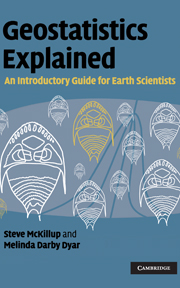Book contents
- Frontmatter
- Contents
- Preface
- 1 Introduction
- 2 “Doing science”: hypotheses, experiments and disproof
- 3 Collecting and displaying data
- 4 Introductory concepts of experimental design
- 5 Doing science responsibly and ethically
- 6 Probability helps you make a decision about your results
- 7 Working from samples: data, populations and statistics
- 8 Normal distributions: tests for comparing the means of one and two samples
- 9 Type 1 and Type 2 error, power and sample size
- 10 Single-factor analysis of variance
- 11 Multiple comparisons after ANOVA
- 12 Two-factor analysis of variance
- 13 Important assumptions of analysis of variance, transformations and a test for equality of variances
- 14 Two-factor analysis of variance without replication, and nested analysis of variance
- 15 Relationships between variables: linear correlation and linear regression
- 16 Linear regression
- 17 Non-parametric statistics
- 18 Non-parametric tests for nominal scale data
- 19 Non-parametric tests for ratio, interval or ordinal scale data
- 20 Introductory concepts of multivariate analysis
- 21 Introductory concepts of sequence analysis
- 22 Introductory concepts of spatial analysis
- 23 Choosing a test
- Appendices
- References
- Index
2 - “Doing science”: hypotheses, experiments and disproof
Published online by Cambridge University Press: 05 June 2012
- Frontmatter
- Contents
- Preface
- 1 Introduction
- 2 “Doing science”: hypotheses, experiments and disproof
- 3 Collecting and displaying data
- 4 Introductory concepts of experimental design
- 5 Doing science responsibly and ethically
- 6 Probability helps you make a decision about your results
- 7 Working from samples: data, populations and statistics
- 8 Normal distributions: tests for comparing the means of one and two samples
- 9 Type 1 and Type 2 error, power and sample size
- 10 Single-factor analysis of variance
- 11 Multiple comparisons after ANOVA
- 12 Two-factor analysis of variance
- 13 Important assumptions of analysis of variance, transformations and a test for equality of variances
- 14 Two-factor analysis of variance without replication, and nested analysis of variance
- 15 Relationships between variables: linear correlation and linear regression
- 16 Linear regression
- 17 Non-parametric statistics
- 18 Non-parametric tests for nominal scale data
- 19 Non-parametric tests for ratio, interval or ordinal scale data
- 20 Introductory concepts of multivariate analysis
- 21 Introductory concepts of sequence analysis
- 22 Introductory concepts of spatial analysis
- 23 Choosing a test
- Appendices
- References
- Index
Summary
Introduction
Before starting on experimental design and statistics, it is important to be familiar with how science is done. This is a summary of a very conventional view of scientific method.
Basic scientific method
The essential features of the “hypothetico-deductive” view of scientific method (see Popper,1968) are that a person observes or samples the natural world and uses all the information available to make an intuitive logical guess, called a hypothesis, about it or how it functions. The person has no way of knowing if their hypothesis is correct – it may or may not apply. Predictions made from the hypothesis are tested, either by further sampling or by doing experiments. If the results are consistent with the predictions then the hypothesis is retained. If they are not, it is rejected, and a new hypothesis formulated (Figure 2.1). The initial hypothesis may come about as a result of observations, sampling and/or reading the scientific literature.
Here is an example. Lead contamination is an enormous environmental problem because in the past many manufacturers discarded wastes containing lead and other heavy metals into pits and landfills. These heavy metals are water soluble so they can leach into aquifers, be transported by groundwater and contaminate water supplies. In the early days, clean-up of these sites involved digging up the contaminated soil and removing it to special disposal facilities where water run-off could be contained and treated.
- Type
- Chapter
- Information
- Geostatistics ExplainedAn Introductory Guide for Earth Scientists, pp. 8 - 14Publisher: Cambridge University PressPrint publication year: 2010



